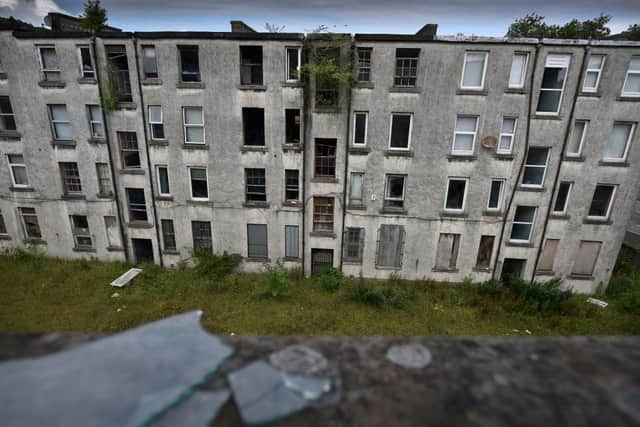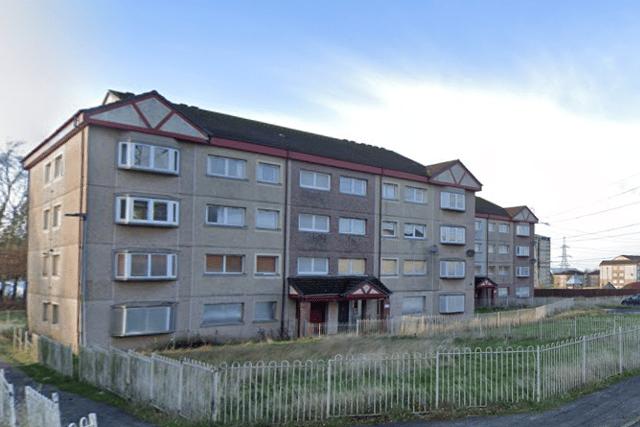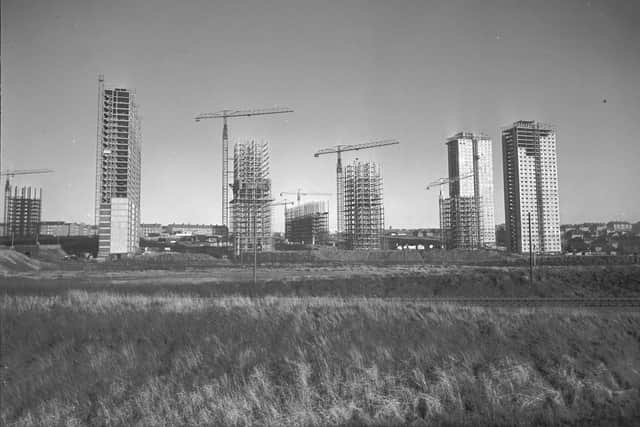Ghost towns of Glasgow: Five forgotten schemes in and around the city
and live on Freeview channel 276
Glasgow’s housing has gone through generations of change from the red and blonde sandstone tenementsto the imposing high-rise towers but there was lot of housing developments that the city lost along the way.
Schemes were more than just housing or accomodation blocks, they were communities with friends and families - all linked by their common post code. In this article we wanted to look at some of Glasgow’s forgotten schemes - whether they be derelict abandoned tenements, social housing gone wrong, or the flattened flats that used to dominate the city’s skyline - and remember how they used to be, and what they are now.
Advertisement
Hide AdAdvertisement
Hide AdSo without further adieu, here’s our list of Ghost towns in and around Glasgow.
Clune Park, Port Glasgow


The Clune Park scheme still stands in Port Glasgow today and is an exciting development with a church, primary school, and 430 flats (with great connections to the town centre!) - for all 20 of its residents.
The Inverclyde community now lies derelict, with around 20 residents still clinging onto their homes in the scheme that resembles pictures taken of London’s housing post-blitz in World War II. The estate was a bustling place at one time during the late nineteenth and early twentieth century, when it served as the home for shipworkers contracted at the nearby dock.
The scheme was made up of 45 tenement buildings - a school that remained open for 111 years before closing its doors in 2008. A beautiful Gothic-style church was built in 1905 - but shut 92 years later in 1997 - an incredibly short lifespan for a church. You can buy some of the dilipadated housing in Clune Park for less than £10k - although the proposition isn’t exactly attractive with the neighbourhood falling down around you.
Advertisement
Hide AdAdvertisement
Hide AdInverclyde Council are making a concerted effort to buy up all the housing so they can demolish the estate. Stephen McCabe, Leader of Inverclyde Council, said: “It is a decimated, isolated community. It is a blight on the landscape.
“It is one of first things you see coming into Port Glasgow on the train. It would remind you of somewhere like Chernobyl.”
Gowkthrapple, Wishaw


The Gowkthrapple scheme (known locally as Gowky) housed generations of Wishaw families, built on the very edge of the town - down the road from the abattoir and post-war housing scheme Pather. North Lanarkshire Council hopes to demolish the estate, announcing their plans in 2017, leading to a mass exodus of the remaining 1330 residents.
It is said by the council that the estate was unpopular and underoccupied, having gained somewhat of a negative reputation in the local commununity. Given that the scheme is located on the very outskirts of Wishaw, it suffered from an underprovision of direct services - much akin to Glasgow’s Easterhouse.
Advertisement
Hide AdAdvertisement
Hide AdBuilt originally as an estate to house workers at nearby Pather Iron and Steel Works and then Smith’s Clock Factory - both of which were lost when the Wishaw community (adjacent to the Ravenscraig steelworks) were devastated by the death of the Steel industry in the Thatcher years. Now the scheme consists primarily of council housing stock, and had a large Polish and older community in modern years.
At the end of 2022, there is one resident still clinging on to his home in Gowkthrapple - holding up the Council’s plans to demolish the scheme before 2027. Nick Wisniewski, 66, bought his flat in Stanhope Place more than six years ago under the “Right to Buy” scheme. Attempts from the Council to buy the flat off the man for £35k have fallen on deaf ears, as the Gowkthrapple resident is insistent on remaining in his home he lives in with his son. - who have been the sole residents since December 2020.
Red Road Flats


The Red Road Flats were famously more abestos than they were concrete, and were notorious in their time for high crime rates and general deprevation for residents.
At capacity, the six 31-floor towers and two 28-floor ‘slabs’ (wide highrise towers) could hold 4,700 residents. The towers were so tall that on a clear day the towers could be seen from up to 10 miles away and the 30th floor of the taller towers were the highest accomodation avaliable in Glasgow.
Advertisement
Hide AdAdvertisement
Hide AdDemolished in 2015, the towers were infamous across the West of Scotland, with people from far and wide sharing ‘horror stories’ of their experience walking into any of the towers. While the towers did have their share of serious anti-social crime, nearby estates like Blackhill were more affected, but nowhere near as notorious - no doubt an effect of the towering, looming ambience of the Red Road Flats.
In 2015, Glasgow Housing Assocation announced their intention to demolish the flats - this didn’t go unchallenged however, as one pro-council housing group, Defend Council Housing, set up a local campaign against the demolition. However, by 2010, the council had planned the phased demolition for all eight of the towers.
Emblematic of the Council’s shame surrounding the towers, a large spectacle was made of destroying five of the towers ahead of the 2014 Commonwealth Games opening ceremony., with the explosion broadcast live to large screens in Celtic Park. The final six towers came down in a controlled demolition in 2015
Hutchesontown
Hutchesontown in the Gorbals looks very different nowadays - but the scheme was at one time home to some of the worst housing in Glasgow.
Advertisement
Hide AdAdvertisement
Hide AdPrior to the 1950s, the entire area was a slum, full of overcrowded and unsanitary tenement dwellings - of the 7605 dwellings, most had no internal baths or toilets - so the Council of the day decided to raze the entire area to the ground. Hutchesontown became almost unrecognisable from its previous appearance, with blocks of tenements swept away along with several Victorian and Edwardian-era churches as well as civic buildings which nowadays would be considered to be of architectural merit
Unfortunately for residents, the scheme served as a testing ground for similar schemes around the city. It was decided to divide the area into five ‘zones’which were given to different architects to implement a mixture of different schemes.
Hutchesontown ‘A’ was low rise housing, mainly maisonettes completed in the late 1950s nearby Gorbals Health & Sports Centres- there was nothing much wrong with this housing in comparison to whats to come.
Hutchesontown ‘B’, now known as the Riverside Estate, lies directly West of the Strathclyde Grain Distellery and comprised four eighteen-storey blocks, completed in 1964. B is widely regarded as the most successful of the Gorbals high-rises, and have received numerous refurbishments in their lifetime.
Advertisement
Hide AdAdvertisement
Hide AdHutchesontown ‘C’ at Queen Elizabeth Square was the most infamous scheme amongst the new developments, and comprised of an (at the time) award-winning development of ten twenty-storey towers connected by large balconies and arranged in two large slabs. HM Queen Elizabeth II visiting the site and unveiling a foundation plaque in 1961. The flats were completed in 1965 and demolished in 1993.
Hutchesontown ‘D’ was the largest area and included four twenty-four-storey towers and three eight-storey blocks. Two of the towers were demolished in early 2006;the remaining two were refurbished, but in 2020 it was confirmed that they too would be demolished in the near future due to issues with the cladding post-Grenfell that was applied in previous work and the prohibitive cost of fixing the issue.
Hutchesontown ‘E’ comprised of twelve seven-storey deck-access blocks and two twenty-four-storey point towers, completed in 1968. Within a few years, however, the low-rise buildings became badly affected by dampness and condensation problems and were presently declared unfit for habitation; they were finally demolished in 1987. The two towers were condemned in 2010 and were demolished in 2013.
Backlands of Calton
In the early twentieth century, the construction of additional property between tenements - known as the backlands - brought about incredible overcrowding in schemes that were already facing slum conditions.
Advertisement
Hide AdAdvertisement
Hide AdThere were more than a thousand backland properties in Calton - and become such an issue that the Government had to step in to provide increased funding to allow the Glasgow corporation to clear the slums. Around 1365 backland homes were demolished in the 1930s, leading to an end to the cramped conditions in what essentially were Tenement forecourts.
The housing was replaced with 330 homes in three story tenements built in open spaces - around 20 per cent of Calton residents refused to move, preferring their property in the backlands - with a further 10 per cent returning to the backlands after leaving, despite the offer of larger accomodation at a lower rent.
Comment Guidelines
National World encourages reader discussion on our stories. User feedback, insights and back-and-forth exchanges add a rich layer of context to reporting. Please review our Community Guidelines before commenting.
